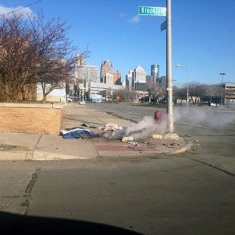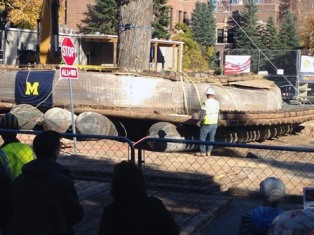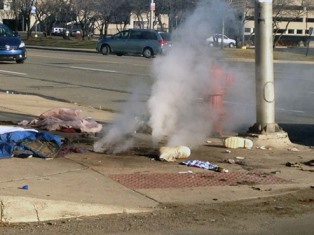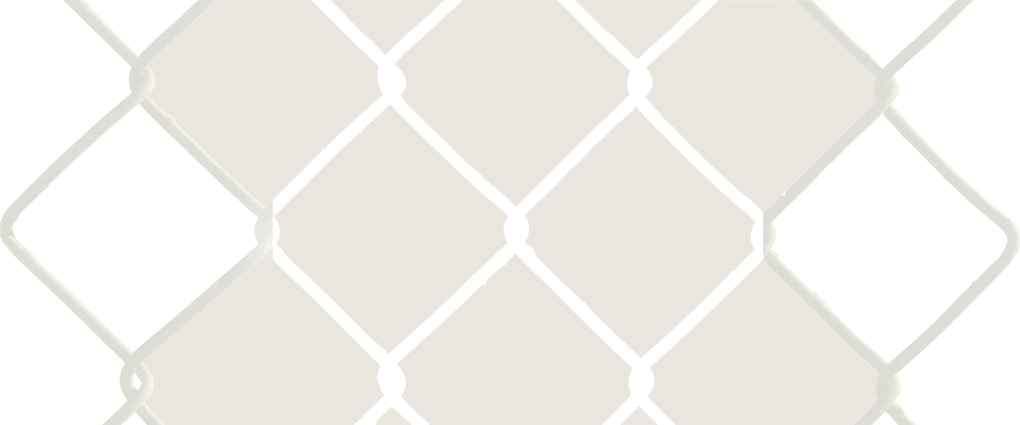 |
 |

|

|

|

|
Ross School of Business, University of Michigan Ann Arbor, Michigan
October, 20, 2014
After hearing an NPR/WUOM announcement about the University of Michigan relocating a 260-year-old oak tree a few hundred yards due to new campus construction, we had to take a family trip west to Ann Arbor to witness. Uncertain what we would find, witnessing the action was important. The attraction remained vague; was it cultural? Was it a desire connected to an environmental cause aligned with green sensibilities? Or, maybe we thought that we cleverly found an unrealized Robert Smithson work. Regardless the reason, the performance also instilled a sense of gravity onto hundreds of spectators who we joined and stood amongst behind a chain-link fence watching the slow movement of a tree.
I do not know the age of trees when I see them like when I see a person. In the presence of a fellow two-legged, my brain tells me their age as either a teenager, middle-aged, a senior citizen and about to die. Hair dye and make-up does not hide the visual clues. But with a tree, I have no idea, which is probably the same for most. We all watch trees lose their leaf wigs in the fall and re-wear them in the spring, but this cycle doesn’t give us a clue. On the tree-moving occasion, press releases distributed about the tree’s age. Broadcasting such an attribute was supposed to mean something. I repeated it to my colleagues. It became a headline running through my head, my own private circus barker calling me to come and witness the shape of time, the possibility to see it, touch it, stand in awe of it, instead of having to live through it, to be subjected to it. We could separate ourselves from time. I photographed the event from all angles and took videos. Some spectators brought camp chairs for comfort while viewing the slow movement of an uprooted tree, others brought dogs, at least one brought marijuana, and several brought more advanced photographic equipment.
Turning to the photos, I do not see the shape of time in them. I do not see the Kantian sublime, or any clues helping us understand the perception of the unknowable. This begs the question as to why we and hundreds of spectators elevated a construction site into a cultural event.
The only absolutes are shit and death and time is a necessary condition for these truths. For humanity, time is essential - to love, to touch, to cry, to be bored all require time. But time is unknowable and unseeable; it leaves traces only after its subjection. The 260- year- old oak - its age on display, ripped from the ground - is a hope for further understanding of time; a chance to witness it outside of the underlying condition of existence. |
Corner of Fort and Brooklyn, Detroit, Michigan
December 29, 2014
With the cold weather comes abundant signs of Detroit’s past alignment with the industrial revolution. Namely: steam rising from manhole covers. But, today, steam spotting was more complex. The steam became a hot bath for several homeless people. From the cozy sanctum of our car and after being filled with overrated ramen down the street, we watched in amazement at how the nameless made themselves disappear further into the ground in the midst of low-hanging clouds by lying on top of where the steam escapes from the sidewalk. The weight of their downtrodden bodies kept the heat down on the ground just a little longer before infinitely rising and dissolving into the atmosphere once it reached its cooling point.
Contemporary life’s training set in as I felt guilt about snapping a photo (the photo provided is from the next day when I felt o.k. being in a warm, new car photographing the homeless from a distance) but the grounded cloud-dwellers became invisible. I guess they fully disappeared into the light of day or I trained myself not to look.
Seeing the ever-changing form of heat against Detroit is, for lack of better words, poetic. The drama of the city is all made of human consequence, the residue of the infinite march towards the acquisition of capital. Material wealth rotting and reconstituting itself like cooled fat from the sauce in leftovers. (Will I live long enough or stay in Detroit long enough to see this newfound extraction of material goods from Detroit re-liquefy again?) The creation and disappearance of heat visible to the eye is a constant reminder of the insignificance of culture. It doesn’t even register in the geological measurement of time. Maybe what is amazing is the speed of the build/demolish/rebuild culture setting the scene for the next cycle. Searching for meaning by trying to acquire the feeling of participation in an empire that raised, collapsed, and rebuilt all in the span of a human life…
Being practicing artists and historians, we have studied how the collision of art and the everyday have come in and out of favor in several different iterations through the brief history of contemporary practices. It has become almost a reflex to consider moments of beauty outside of art as potential art. Mary and I have a predilection to hone in on moments of human traces colliding with natural systems. With this training in hand, and using the car window as a framing mechanism, it is easy to see the poetics of the indignity of lying in the street atop steam escaping a manhole cover to keep warm as beauty. But, the act of opening the door destroys the moment and the complexities of culture flood in. |
I trained myself to consider the tree and steam events as art. Since witnessing them, I struggle to find a theoretical framework to support such a thought. Initially, I considered Nicolas Bourriaud’s Relational Aesthetics (Les Presse Du Reel, Franc, 1998) as an answer. At the time, they felt like mini utopias, illustrating his idea of a “social interstice.” They create communities, experiences and exchanges that seem to lie outside the explicit strictures of capitalism. We gathered round the tree and created an impromptu parade of slowness, convening to celebrate something that subtly and quietly defies the perpetual present of digital culture. The waste, the slag, from the inefficiency of steam heat was used in a new, unintended form, a form not entirely outside conventional processes of capital exchange but, in some ways, perhaps, diagonal or perpendicular. A living, breathing, instruction manual on how to ab-use the grid lay before me. But ethics took hold of my better judgment and poked holes in such an argument. I even coldly joked and half-heartedly thought about repurposing the steam for public cooking.
Next, I thought, maybe I just need to reconsider the definition of art. My knowledge returned me to the last time I knew of when the rhetorical limits of how to consider art were in question. In 1979 on the pages of the article “Sculpture in the Expanded Field,” (October, 1979) Rosalind Krauss attempts to create an inclusive position to the rapid, pluralistic expansion of methods of art production. If we are to have a critical culture, we need to know what we are engaging with, which, in effect, is a genus. In a seemingly simplistic move, to deal with art breaking-out of the gallery and into the landscape, Krauss refers to it as “not-landscape” or “not-architecture.” Thus keeping the qualities of such modes of production out of the discussion of the merits of the work in question. A minimal semantic leap can purge the ethics and political polemics from what I am proposing as art. But texts and speech utterances don’t resolve the issue.
My university training still is at odds with the poetic potency of materials. If the steam and tree events that I witnessed are considered art, a flood of historical, political and social baggage becomes part of the work that pulls it into another form of being. Looking back to an unlikely source of ideas on this topic, I find a possible answer by misusing Clement Greenberg’s theories in his essay “Modernist Painting":
What had to be exhibited was not only that which was unique and irreducible in art in general, but also that which was unique and irreducible in each particular art. Each art had to determine, through its own operations and works, the effects exclusive to itself… it would make its possession of that area all the more certain (Greenberg. “Modernist Painting”. http://cas.uchicago.edu/workshops/wittgenstein/files/2007/10/Greenbergmodpaint.pdf).
The steam was acting explicitly in the realm of the material qualities of steam; demonstrating its heat through being used as makeshift heater and its visibility in the cool air. By uprooting the tree, its intrinsic tree-ness is being demonstrated; its immobility, its scale and rate of growth. Calling these events “art” in 2015 imposes a responsibility on the events. More and more art is being asked to solve issues outside of its scope. While opening art to a larger audience has endless potential to benefit culture at large, we need care that it does not merely become a rhetorical tool in the service of fixing other disciplines.

Greenberg, Clement. “Modernist Painting”. Forum Lectures (Washington, D. C.: Voice of America), 1960. Arts Yearbook 4, 1961 (unrevised). Art and Literature, Spring 1965 (slightly revised). http://cas.uchicago.edu/workshops/wittgenstein/files/2007/10/Greenbergmodpaint.pdf
Krauss, Rosalind. "Sculpture in the Expanded Field". October. Vol. 8: Spring, 1979: pp. 30 - 44 |
|





